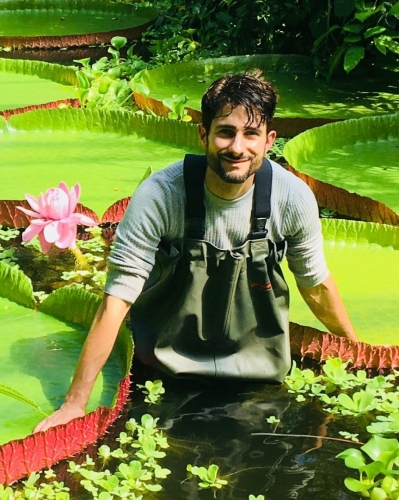Dr Chris Thorogood, Deputy Director and Head of Science at the Oxford Botanic Garden and Arboretum
The leaves of giant Amazonian waterlilies are some of the most astounding feats of engineering in nature. They are the largest floating leaves of any plant, growing to nearly three metres in diameter, and they form vast networks on the surface in the River Amazon. For centuries they have been grown in botanic gardens and have inspired artists, engineers, and architects. Indeed, they have been grown at Oxford Botanic Garden since the 1800s. Professor Charles Daubeny commissioned the construction of a new glasshouse, containing a great tank heated by hot water flowing through pipes, for their cultivation. The plant flowered in 1853 and it has been grown at the garden in the same tank ever since, inspiring visitors to this day.
Despite the archetypal beauty and scale of this botanical enigma, little is known about the mechanics of its extraordinary leaves. How and why they achieve such gigantic proportions remained a mystery until recently. Together with physicists at other universities around the world, I examined the plant that grows in the heated pond here at Oxford Botanic Garden. We looked at the mechanical properties of the leaves and sought to find out the how vascular architecture (the striking pattern of connective ‘girders’) differs from that of other waterlilies with smaller leaves. We loaded the leaves with weights to see what load they could carry and examined how the leaves deformed. Then, using mathematical simulations to compare the giant leaves, which have a complex geometry, with the simpler floating discs of smaller waterlilies we found that these giant leaves are stiffer than their smaller-leaved relatives; the regular branching pattern gives them a greater rigidity for a given volume of plant matter. In other words, the leaves are able to achieve gigantic proportions at low ‘cost’. Our work was published recently in Science Advances: science.org/doi/10.1126/sciadv.abg3790

But why do the leaves grow so big? Natural selection favours leaves that maximise their surface area for photosynthesis – the bigger the better we might think – but their size is limited by strength and maintenance; larger leaves are more expensive to maintain. Growing large leaves quickly and cheaply may have enabled the giant Amazonian waterlily to occupy a large surface area for light capture and outcompete the surrounding vegetation in the fast-drying pools where it evolved. Why is this work important? The load-bearing properties of these incredible leaves could inspire cost-effective engineering solutions for designing floating platforms for renewable energy production. Examples of this could include solar panels, or even the development of offshore societies.









